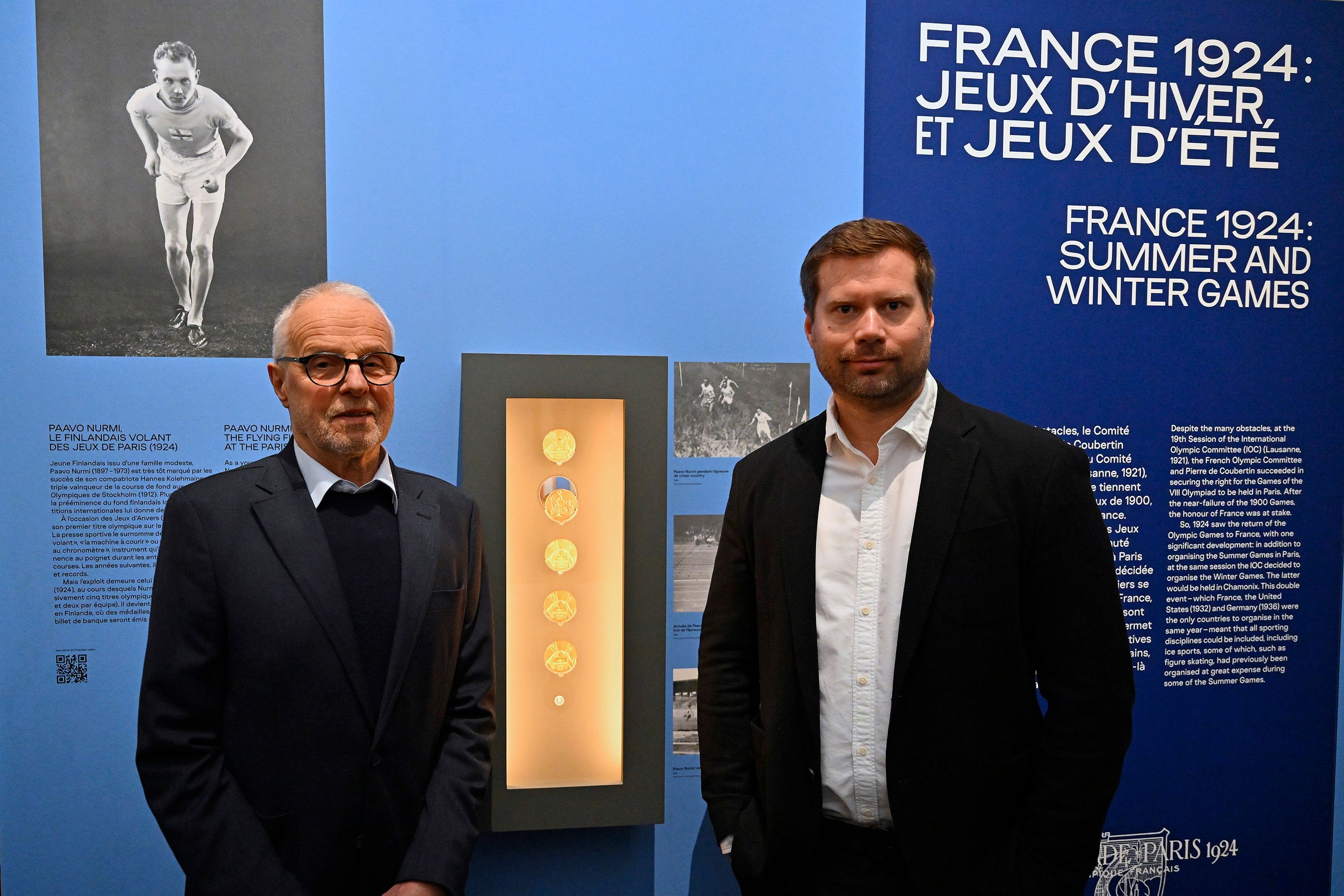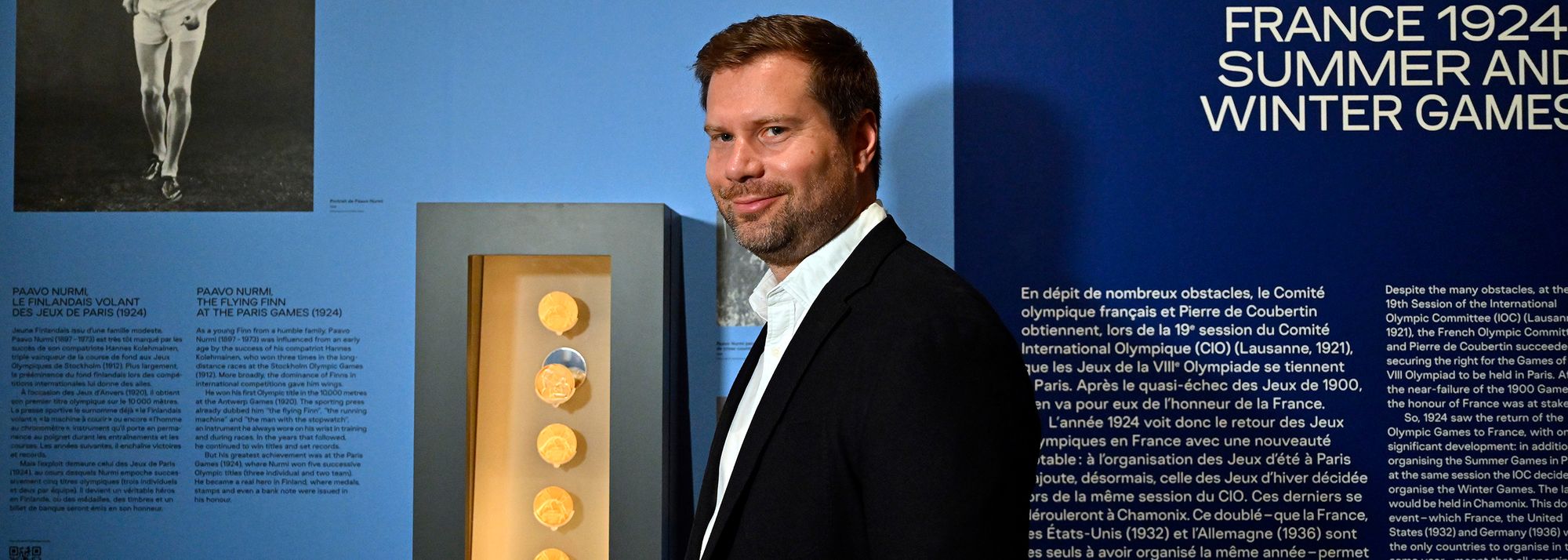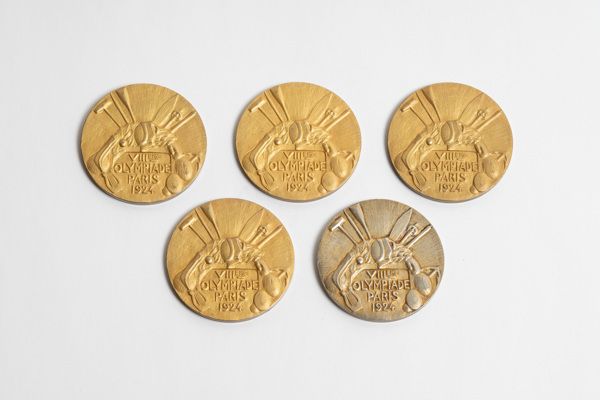Mika Nurmi with the Paris 1924 Olympic gold medals won by his grandfather Paavo Nurmi (© Aurelien Meunier - Getty Images for World Athletics Heritage)
Mika Nurmi, the grandson of Paavo Nurmi, was in the heart of the French capital for today's public opening of an exhibition in which his grandfather's Paris 1924 Olympic gold medals – an unsurpassed total of five athletics gold medals from a single Games – are the centrepiece.
Nurmi's medals, which have seldom been displayed in Finland and had not left the country since they were won a century ago, have returned to Paris to help celebrate this year's Olympic Games in Paris, which joins London as the only three-time host of the summer Olympic Games.
Joining Nurmi at the exhibition “D’or, d’argent, de bronze. Une histoire de la médaille Olympique”, which is housed in the museum of the Monnaie de Paris on the left bank of the Seine, was Lasse Viren, Finland's four-time Olympic champion who won 5000m and 10,000m doubles at the Munich 1972 and Montreal 1976 Olympic Games.
Elusive opponent
Paavo Nurmi (1897-1973) was one of the all-conquering ‘Flying Finns’ who in the first half of the 20th century dominated the world of middle- and long-distance running. The man from Turku inherited the mantle of the world’s greatest runner from fellow Finn Hannes Kolehmainen (1889-1966) of Kuopio, the Stockholm 1912 Olympic 5000m and 10,000m champion, who returned to the Olympic stage in Antwerp 1920 to win the marathon title.
The Antwerp Games was the first of three Olympics in which Nurmi competed. In Antwerp, Paris and Amsterdam (1928), he ran distances ranging from 1500m to 10,000m, including 3000m steeplechase and cross country running, winning a total of nine gold and three silver medals.
Yet it was Nurmi's triumphs at Paris 1924, especially a jaw dropping 1500m and 5000m double within a period of less than 90 minutes between the two finals, which sealed his legendary Olympic status.

Lasse Viren and Mika Nurmi with the 1924 Olympic Games medal die (© Aurelien Meunier - Getty Images for World Athletics Heritage)
The story of the cross country race (6.84km) has itself gone down in Olympic history. The official report noted that the temperature was 45°C generally but that an industrial chimney near the river Seine affecting two thirds of the race meant that the air temperature for that section was as much as 60°C (140°F). Of the 38 starters, 23 failed to finish, and several athletes were taken to hospital after collapsing.
Despite the weather conditions, Nurmi took the cross country race with relative ease, winning by some 400 metres from fellow Finn Ville Ritola. The manner of Nurmi’s victory was remarkable considering Ritola himself won four golds and two silvers in Paris.
In Paris, Nurmi was in competition so elusive, so untouchable an opponent, that US sportswriters began referring to him as 'The Phantom Finn'.
Mika Nurmi commented: “It is special moment for our family to know that my grandfather’s Olympic achievements are being recognised in this prestigious museum, and that his medals will be on show for Parisians and visitors from around the world to view for the next six months.
“My grandfather rarely gave interviews and he was almost as famous for his silence as he was for his athletic prowess, which made him the biggest of names in world sport. His athletics achievements have stood the test of time, the awe they inspire 100 years later says everything about the stature of his running career.”
Viren commented: “I never got to meet Paavo Nurmi. We had a meeting organised on the day on which he sadly passed away. Amazingly, this is the very first time that I have ever even seen his Paris gold medals.
“Nurmi’s name remains very well known in Finland. He is a national hero. It is wonderful that his achievements are being honoured in this excellent exhibition in the city which witnessed the greatest of his victories.”

Lasse Viren and Mika Nurmi with Paavo Nurmi's Paris 1924 Olympic gold medals (© Aurelien Meunier - Getty Images for World Athletics Heritage)
Homecoming
What makes the display particularly remarkable is that it was the Monnaie de Paris, the world's oldest national mint, which struck the medals for the 1924 Olympic Games. The medal dies remain housed in the museum to this day. Their display here is the ultimate homecoming for the gold medals which mark Paavo Nurmi’s dominant victories in the 1500m, 3000m team, 5000m, cross country individual and team races in 1924.
Nurmi’s Paris golds form just one part of the exhibition “D’or, d’argent, de bronze. Une histoire de la médaille Olympique”, which has been organised by the museum of the French mint to mark the Olympic Games of Paris 2024.
Dominique Anterion, curator of the historical collections at La Monnaie de Paris and of the exhibition, has designed and delivered a fascinating exploration of the history of the Olympic medal, highlighting its evolution through the editions of the modern Olympic Games.
The exhibition, which is a must see for all sports fans, is open to the public until 22 September 2024.
The display of Nurmi’s five gold medals has been made possible thanks to the kind agreement of the Nurmi family to loan the medals, and the sponsorship of World Athletics Heritage & the Museum of World Athletics who have joined with the Paavo Nurmi Games and the Monnaie de Paris to facilitate this rare exhibit.
World Athletics Heritage






